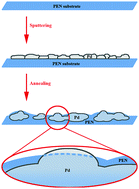 Resistance of pathogenic bacteria to conventional antibiotics has emerged in recent years as a major problem for public health. In order to overcome this problem, non-conventional antimicrobial agents have recently been under investigation. Pd nanolayers of variable thicknesses ranging from 0.4 to 22.4 nm were prepared by sputtering on polyethylene naphthalate (PEN). Low-temperature annealing was applied to transform these nanolayers into discrete nanoislands homogeneously distributed over the surface of the underlying polymer. The antibacterial properties of these composites were evaluated by drip test using Gram-positive and Gram-negative bacteria as model strains. Inductively coupled plasma, X-ray photoelectron spectroscopy, and atomic force microscopy were used to outline the method of bacterial inhibition by Pd nanostructures. We found that the antibacterial effect of the Pd/PEN composites might be caused by both (i) release of Pd into a physiological solution and (ii) direct contact of bacteria with the Pd/PEN composites. Our results suggest that the samples coated with a 22.4 nm thick Pd layer exhibited significantly enhanced antibacterial properties than the thinner Pd layers.
Resistance of pathogenic bacteria to conventional antibiotics has emerged in recent years as a major problem for public health. In order to overcome this problem, non-conventional antimicrobial agents have recently been under investigation. Pd nanolayers of variable thicknesses ranging from 0.4 to 22.4 nm were prepared by sputtering on polyethylene naphthalate (PEN). Low-temperature annealing was applied to transform these nanolayers into discrete nanoislands homogeneously distributed over the surface of the underlying polymer. The antibacterial properties of these composites were evaluated by drip test using Gram-positive and Gram-negative bacteria as model strains. Inductively coupled plasma, X-ray photoelectron spectroscopy, and atomic force microscopy were used to outline the method of bacterial inhibition by Pd nanostructures. We found that the antibacterial effect of the Pd/PEN composites might be caused by both (i) release of Pd into a physiological solution and (ii) direct contact of bacteria with the Pd/PEN composites. Our results suggest that the samples coated with a 22.4 nm thick Pd layer exhibited significantly enhanced antibacterial properties than the thinner Pd layers.
Keywords: complexes; infections; polymer
